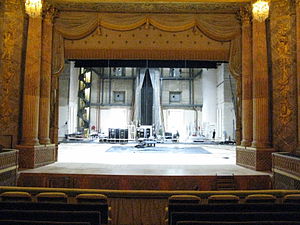Théâtre Gabriel

View of the stage
|
|
| General information | |
|---|---|
| Architect | Ange-Jacques Gabriel |
| Decorator | Augustin Pajou |
| Construction dates | 1763-1770 |
| Date of inauguration | 16 May 1770 |
| Inaugural occasion | Marriage of the dauphin (future Louis XVI) with archduchess Marie-Antoinette of Austria |
| Seating, as a theater | 712 |
| Accommodation as salle de spectacle | 1,200 |
| Construction material |
|
| Central ceiling painting | Apollo preparing the crowns for illustrious Men of the Arts by Louis Jean-Jacques Durameau (1733-1796) |
The Royal Opera of Versailles (French: Opéra royal de Versailles) is the main theatre and opera house of the Palace of Versailles. Designed by Ange-Jacques Gabriel, it is also known as the Théâtre Gabriel. The interior decoration by Augustin Pajou is constructed almost entirely of wood, painted to resemble marble in a technique known as faux marble. The excellent acoustics of the opera house are at least partly due to its wooden interior.
The house is located at the northern extremity of the north wing of the palace. General public access to the theater is gained through the two-story vestibule. Some parts of the Opéra, such as the King's Loge and the King's Boudoir represent some of the earliest expressions of what would become known as Louis XVI style.
Lully’s Persée — written in 1682, the year Louis XIV moved into the palace — inaugurated the Opéra on 16 May 1770 in celebration of the marriage of the dauphin — the future Louis XVI — to Marie-Antoinette.
The Opéra Royal can serve either as a theater for opera, stage plays, or orchestral events, when it can accommodate an audience of 712, or as a ballroom, when the floor of the orchestra level of the auditorium can be raised to the level of the stage. On these occasions, the Opéra can accommodate 1,200.
During the French Enlightenment, the theatre became a place where political and social ideas were considered myths and superstitions were tested. As more Enlightenment thinkers began to question the tenets of religion, many eighteenth-century citizens began to replace the pulpit with the stage, and looked to the theatre for their moral instruction as well as entertainment. The nobility had a lot to do with the uprising of theatre during this time. Louis XIV, who is known as the "Sun King" for playing the allegorical character of the sun in "The Ballet of the Night" in 1653, moved his royal court from the capital, Paris, to Versailles, aspiring to get more control of the government. The Opera, which was built for Louis XV, however, was not built until later. His mistress, Marie de Pompadour, patronized artists, actors, and musicians while bankrupting France. Meanwhile, the aristocracy and church paid no taxes, and the bourgeoisie picked up the tab for the monarchy's tastes and fun. Yet, it was not until after the death of Louis' mistress that the construction of the Opera began.
...
Wikipedia
